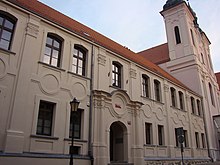Chojnice
Chojnice (Polish: [xɔjˈɲit͡sɛ] ⓘ; Kashubian: Chònice or Chòjnice; German: Konitz or Conitz) is a town in northern Poland with 38,789 inhabitants, as of June 2023,[1] near the Tuchola Forest.
Chojnice was founded around 1205[2] in Gdańsk Pomerania (Pomeralia), a duchy ruled at the time by the Samborides, who had originally been appointed governors of the province by Bolesław III Wrymouth of Poland.
Gdańsk Pomerania had been part of Poland since the 10th century, with few episodes of autonomy, yet under Swietopelk II, who came into power in 1217, it gained independence in 1227.
In 1454 King Casimir IV Jagiellon re-incorporated the territory to the Kingdom of Poland, and the townspeople overthrew the pro-Teutonic town council in attempt to join Poland, however the council with the Teutonic Knights recaptured the town shortly after.
[8] On 18 September 1454 the Polish army led by King Casimir IV Jagiellon lost the Battle of Chojnice.
[8] Shortly before the end of the war the troops of the Teutonic Order, led by Captain Kaspar Nostitz von Bethe, surrendered the town in 1466 to the Polish army led by Piotr Dunin, after a three-month siege,[9] as the last Teutonic-held town in Gdańsk Pomerania.
[10] After the Second Peace of Thorn of 1466 the Teutonic Knights renounced any claims to Chojnice, and the town became again part of Poland.
[11][10][9] In this time the Barons of Betha who traditionally ruled the city left the town and took up residence in the Prussian and Austrian courts.
[12] Cloth production was the main branch of the local economy, and in 1570, clothiers constituted 36% of all craftsmen in the town.
[19] One of the main escape routes for insurgents of the unsuccessful Polish November Uprising from partitioned Poland to the Great Emigration led through the town.
[20] In 1911 the first Polish secret scout troop in the Prussian Partition of Poland was established in the town by Szczepan Łukowicz [pl], who as a military officer later fought in defense of Poland during the Polish–Soviet War (1920) and the German Siege of Warsaw (1939), and was murdered by the Germans during World War II.
During the time span 1900–1902 the Konitz ritual murder case & antisemitic pogrom was committed by the Germans.
During the Nazi German invasion of Poland Wehrmacht troops occupied Chojnice on September 1, 1939, in the morning at 4:45 o'clock.
[27] From late October 1939 through early 1940, mass executions were conducted by SS and the German police as part of the Intelligenzaktion, an action against the Polish intelligentsia.
[28] In total, by January 1940 900 Poles and Jews from Chojnice and its surrounding villages were killed,[27] including parliamentarians, teachers, merchants, postal workers, border guards, priests, farmers.
[29] Hans Kruger - a Nazi activist - became a judge in Chojnice, and during his rule executions of the local population followed.
[30] On January 18, 1945, the Germans carried out a single large massacre in the Igły Valley, in which they murdered some 800 Poles.
The influence of World War II is evident in the 1948 census showing that the population was reduced by 1,900 people compared to 1933.
After World War II Germans inhabitants either fled or were expelled from the city in accordance with the Potsdam Agreement.





